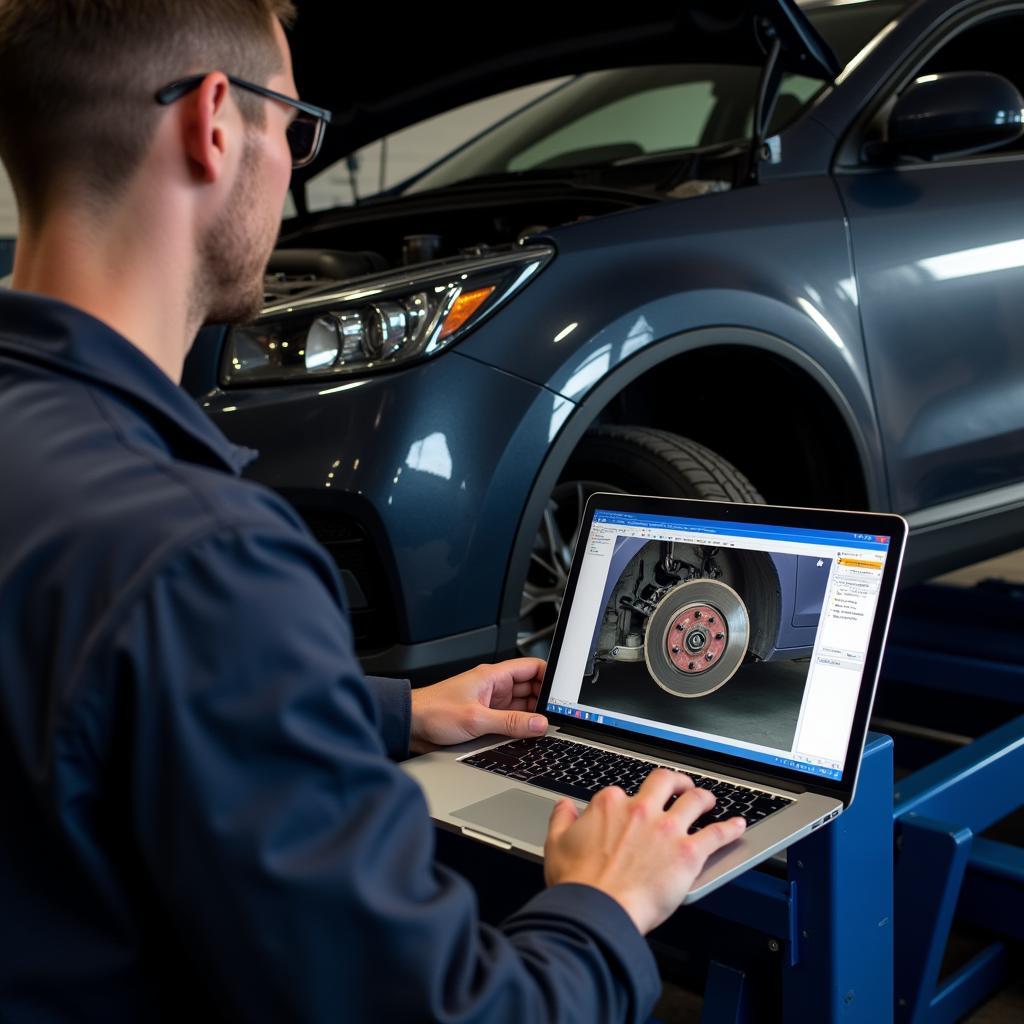A car warning light for the brake system illuminating on your dashboard is a clear sign that something is wrong and requires immediate attention. Ignoring this warning could lead to serious safety risks and potentially expensive repairs. This comprehensive guide will provide you with all the essential information you need to understand the brake warning light and how to address it effectively.
Understanding the Brake Warning Light
The brake warning light, often represented as a bright red or yellow symbol on your dashboard, serves as your car’s primary method of communication about the health of your braking system. While the specific symbol might vary slightly depending on the make and model of your vehicle, its purpose remains the same – to alert you to potential issues within this crucial safety system.
Common Reasons for the Brake Warning Light to Turn On
Understanding why the brake warning light is on is crucial to take appropriate action. Here are the most common reasons behind this warning:
-
Engaged Parking Brake: This is the most straightforward reason. If your parking brake is even slightly engaged, the warning light might turn on. Disengaging the parking brake should resolve the issue.
-
Low Brake Fluid Level: Brake fluid is the lifeblood of your car’s braking system. A drop in brake fluid level often indicates a leak in the system, which needs immediate professional attention.
-
Worn Brake Pads: Brake pads are designed to wear down over time. When they reach a certain level of wear, the brake warning light activates, signaling the need for replacement.
-
Faulty Brake Light Switch: The brake light switch is responsible for activating your brake lights when you press the brake pedal. A malfunctioning switch can also trigger the brake warning light.
-
ABS Issue: If your vehicle is equipped with an Anti-lock Braking System (ABS), a problem within the system can illuminate the brake warning light. This could be due to a malfunctioning sensor or a problem with the ABS module.
What to Do When the Brake Warning Light Turns On
- Don’t Panic: While the brake warning light can be alarming, it’s crucial to remain calm and pull over safely.
- Check Your Parking Brake: As mentioned earlier, ensure your parking brake is fully disengaged.
- Inspect Brake Fluid Level: If it’s safe to do so, carefully check the brake fluid level in the reservoir. If the level is low, do not drive the car and contact a mechanic immediately.
- Avoid Driving: If the warning light persists even after disengaging the parking brake and the brake fluid level seems fine, it’s best to avoid driving and contact a qualified mechanic for diagnosis and repair.
Remote Diagnostics and Software Solutions for Brake System Issues
In today’s technologically advanced world, remote diagnostics and software solutions are becoming increasingly prevalent in the automotive industry. For certain brake system issues, remote diagnostics can be a valuable tool.
- Identifying the Problem: Skilled technicians can remotely access your car’s onboard computer system to retrieve diagnostic trouble codes (DTCs). These codes provide valuable insights into the nature of the problem.
- Software Updates and Reprogramming: In some instances, brake system issues can be resolved through software updates or reprogramming. This can often be done remotely, saving you time and potentially costly repairs.
However, it’s crucial to remember that remote diagnostics have limitations. Physical inspections and repairs might still be necessary for issues such as worn brake pads or fluid leaks.
 Mechanic Performing Remote Diagnostics on Car Brake System
Mechanic Performing Remote Diagnostics on Car Brake System
Preventing Future Brake System Issues
Taking preventative measures can help maintain a healthy brake system and minimize the chances of encountering warning lights:
- Regular Brake Inspections: Adhere to your car manufacturer’s recommended maintenance schedule for brake inspections.
- Timely Brake Pad Replacement: Replace your brake pads as soon as they reach their wear limit.
- Quality Brake Fluid: Use high-quality brake fluid and ensure it’s flushed and replaced at regular intervals as recommended by your car manufacturer.
- Be Attentive to Warning Signs: Pay attention to any unusual noises or sensations while braking, such as grinding, squealing, or vibrations.
Conclusion
The car warning light for brake is a crucial safety feature that should never be ignored. By understanding the common causes, knowing how to react, and taking preventative measures, you can ensure the optimal performance of your braking system and, most importantly, your safety on the road. If you’re ever in doubt or suspect a problem, it’s always best to err on the side of caution and consult a qualified mechanic.
Frequently Asked Questions
1. Can I drive with the brake warning light on?
It’s highly discouraged to drive with the brake warning light on. It could indicate a serious safety concern.
2. How much does it cost to fix a brake warning light issue?
The cost can vary greatly depending on the underlying cause. A simple fix like topping off brake fluid will be significantly cheaper than replacing major brake components.
3. How often should I check my brake fluid?
It’s good practice to check your brake fluid level at least once a month and more frequently if you notice any changes in your brake pedal feel.
4. How long can I drive on worn brake pads?
Driving on worn brake pads is unsafe and can damage other brake components. Replace them as soon as you notice signs of wear.
5. Is it always necessary to take my car to a mechanic for brake warning light issues?
While some simple checks can be done at home, it’s generally recommended to have a qualified mechanic diagnose the problem to ensure a proper and safe repair.
